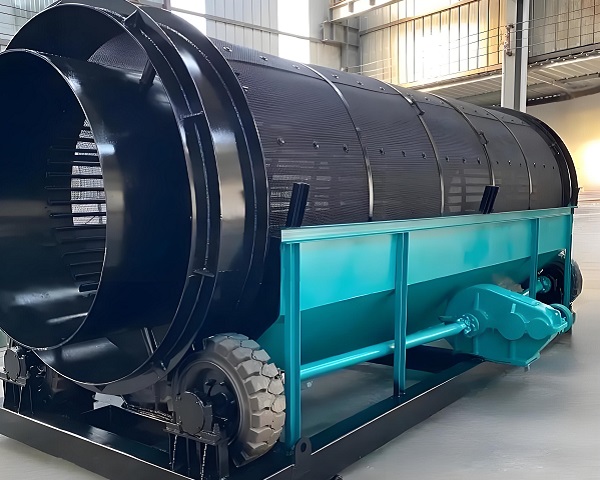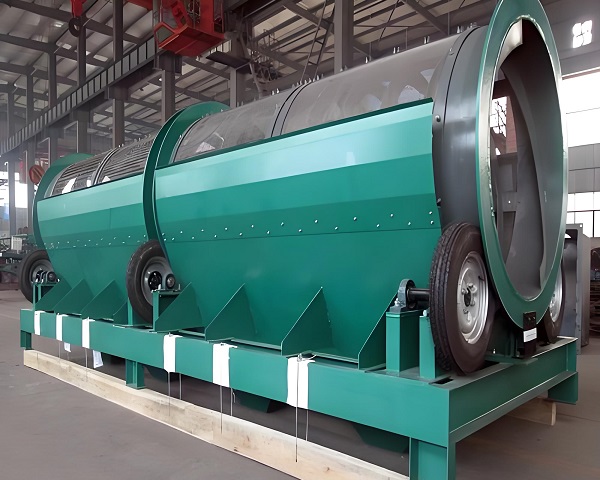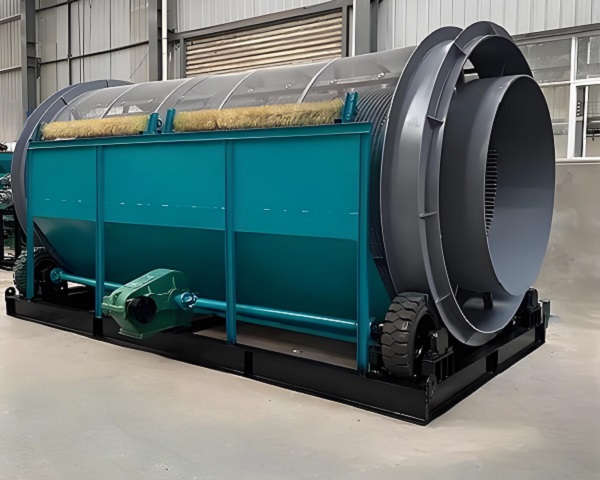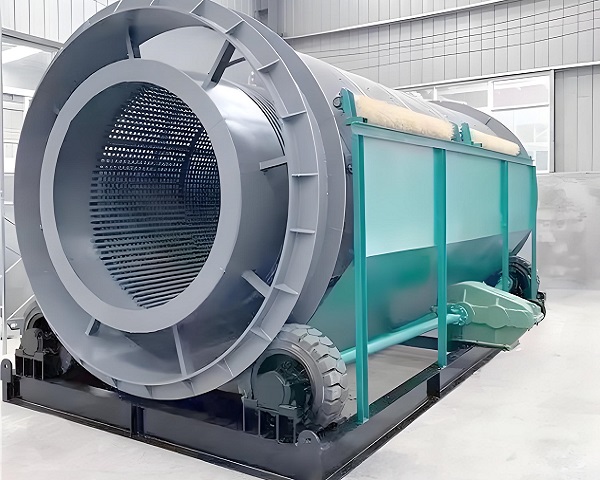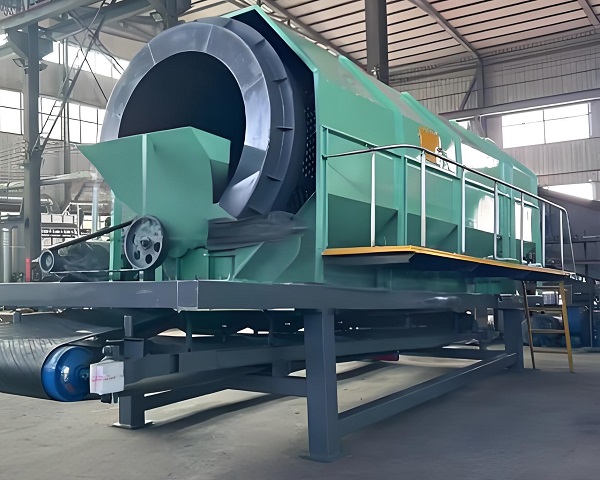A Trommel Screen is a rotary drum screening machine widely used in waste processing, mining, and construction industries. It efficiently separates materials by ......
What is the Shaftless Trommel Screen
The shaftless trommel screen is a screening device designed for high-viscosity, high-humidity, and easily entangled materials. Through the center-shaft-free structure and flexible screening technology, it solves the problem of easy clogging and low efficiency of traditional trommel screens. It is widely used in garbage disposal, biomass power generation, mine tailings treatment and other fields.
1. Core structure and working principle
No center shaft design:
The traditional trommel screen relies on the center shaft to support the screen, while the shaftless trommel screen adopts a ring support beam + flexible screen structure. The screen is directly fixed on the ring frame, and there are no obstacles inside, which completely avoids blockage caused by large pieces of material or fibers winding around the center shaft.
Screening mechanism:
After the material enters the trommel through the feed port, it moves along the axial direction of the trommel under the action of the tilt angle (5°-15°) and the rotational power (8-18r/min). Particles smaller than the screen hole leak out through the screen, and particles larger than the screen hole are discharged from the end. The screen can be designed as an oblong hole, a star-shaped hole or a woven mesh to adapt to different material characteristics.
2. Technical advantages
Strong anti-entanglement ability:
The center-shaft-free structure allows fiber materials (such as kitchen waste and plastic film) to pass through the screen directly, avoiding downtime and cleaning caused by entanglement.
High screening efficiency:
The flexible screen can generate micro-vibration with the movement of the material, promoting the particles to pass through the screen holes, and the efficiency is increased by 15%-20% compared with traditional equipment.
Wide range of application:
It can handle wet materials with a moisture content of ≤40% (such as stale garbage, sludge), large materials (such as construction waste) and light impurities (such as straw and sawdust).
Low maintenance cost:
The screen is easy to replace (single block disassembly time ≤30 minutes), and there is no center shaft wear problem, and the equipment life is extended by more than 30%.
3. Application scenarios
Domestic waste treatment:
Sorting impurities such as plastics and glass in kitchen waste, or handling large pieces in mixed garbage.
Biomass power generation:
Screening fuels such as straw and sawdust, removing impurities such as soil and stones, and improving combustion efficiency.
Mine tailings treatment:
Separate coarse particles from fine-grained tailings to achieve resource recovery.
Wastewater treatment:
Pre-treat large impurities in sludge to reduce the load of subsequent dehydration equipment.
4. Selection points
Screen material:
Use polyurethane coated steel mesh (wear-resistant and corrosion-resistant) for high-humidity materials, and stainless steel woven mesh for high-temperature materials.
Screen hole size:
Choose according to the target particle size, such as ≤30mm for sorting plastics and 50-100mm for screening straw.
Drive mode:
Motor + reducer for fixed equipment, diesel generator + hydraulic drive for mobile equipment.
The shaftless trommel screen solves the pain points of traditional equipment through structural innovation and becomes an ideal choice for screening high-viscosity and high-humidity materials. Its high efficiency, low consumption and easy maintenance have significant advantages in the fields of environmental protection and resource utilization.
Operating principle of Shaftless Trommel Screen
The shaftless trommel screen is a device that achieves material classification through a centerless support structure and rotary screening. It is specially designed for high-viscosity, high-humidity, and easily entangled materials. Its core principle can be summarized as "decentralized screening + flexible dynamic filtration". Through structural innovation, it solves the pain points of easy clogging and low efficiency of traditional trommel screens. The following is an explanation from three aspects: structural characteristics, screening process, and technical advantages.
1. Structural characteristics: decentralized design
No center shaft support:
Traditional trommel screens rely on the center shaft to fix the screen, while the shaftless trommel screen adopts a ring support beam + flexible screen structure. The screen is directly fixed on the ring frame without any obstacles inside, completely eliminating the risk of large pieces of material or fibers winding around the center shaft.
Flexible screen:
The screen is usually made of high-strength steel wire weaving or polyurethane-coated steel mesh. The surface is smooth and has a certain elasticity. It can produce micro-vibration with the movement of the material to promote the passage of particles through the screen hole.
Tilt angle and drive: The trommel is tilted 5°-15° as a whole, and the annular support beam is driven by the motor to rotate (speed 8-18r/min), and the material moves axially under the action of gravity and centrifugal force.
2. Screening process: dynamic classification and self-cleaning
Feeding and preliminary dispersion: The material enters the trommel through the feed port, and is quickly dispersed to the surface of the screen under the action of the tilt angle and rotation force.
Grading screening: Particles smaller than the sieve hole (such as fine sand, organic matter) leak through the screen and enter the collection device below; particles larger than the sieve hole (such as plastic, stone) move along the axial direction of the trommel to the end and are discharged.
Self-cleaning mechanism: The flexible screen generates micro-vibration during rotation, and cooperates with the friction between the materials to automatically remove particles stuck in the sieve hole. For stubborn blockages, reverse rotation or high-pressure spraying can be used to assist cleaning.
3. Technical advantages: efficient anti-blocking and wide adaptability
Strong anti-entanglement ability:
The center-axis-free structure allows fiber materials (such as plastic bags and straw in kitchen waste) to pass through the screen directly, avoiding the shutdown and cleaning of traditional equipment due to entanglement, and improving efficiency by more than 30%.
High screening efficiency:
The micro-vibration effect of the flexible screen can reduce the retention time of particles at the screen hole, and the screening efficiency is 15%-20% higher than that of traditional equipment.
Wide range of application:
It can handle wet materials with a moisture content of ≤40% (such as stale garbage, sludge), bulk materials (such as construction waste) and light impurities (such as plastic film, wood chips), and is not sensitive to the particle size distribution of the material.
Low maintenance cost:
The screen adopts a modular design, the replacement time of a single block is ≤30 minutes, and there is no center shaft wear problem, and the equipment life is extended by more than 30%.
4. Analogy explanation: Analogy to trommel washing machine and filter
trommel washing machine principle:
Similar to trommel washing machine, clothes rotate with the trommel when drying, but shaftless trommel screen focuses more on grading screening rather than dehydration, and uses flexible screen to avoid clothes entanglement.
Filter comparison:
Traditional screens such as fixed filters are easily blocked by impurities; while the flexible screen of shaftless trommel screen is similar to a "moving filter", which achieves self-cleaning through dynamic filtration.
Advantages and features of Shaftless Trommel Screen
The shaftless trommel screen is a screening device designed for high-viscosity, high-humidity, and easily entangled materials. Through the center shaft structure and flexible dynamic screening technology, it solves the problem of easy clogging and low efficiency of traditional trommel screens. Its core features and advantages can be summarized in the following five aspects:
1. No center shaft design, excellent anti-entanglement ability
Structural innovation:
The traditional trommel screen relies on the center shaft to support the screen, which is easily entangled by fiber materials (such as plastic bags and straw) and causes shutdown; while the shaftless trommel screen adopts a circular support beam + flexible screen structure, with no obstacles inside, completely eliminating the risk of entanglement.
Effect comparison:
When processing kitchen waste, traditional equipment needs to be shut down 2-3 times a day to clean up the entanglement, while the shaftless trommel screen can run continuously for more than 72 hours, and the efficiency is increased by more than 30%.
2. Flexible screen self-cleaning, high screening efficiency
Dynamic screening mechanism:
The screen is made of high-strength steel wire weaving or polyurethane coated steel mesh, with a smooth and elastic surface. It generates micro-vibration when rotating, which promotes particles to pass through the screen holes and reduces clogging.
Data support:
When screening stale garbage with a moisture content of 35%, the screening efficiency of the shaftless trommel screen can reach more than 90%, which is 15%-20% higher than that of traditional equipment.
Analogy explanation:
Similar to a "moving filter", it achieves self-cleaning through dynamic filtration without frequent manual intervention.
3. Wide range of applications and strong material compatibility
Multi-scenario coverage:
It can handle wet materials with a moisture content of ≤40% (such as sludge, kitchen waste), bulk materials (such as construction waste) and light impurities (such as plastic film, wood chips), and is not sensitive to the particle size distribution of the material.
Typical cases:
Biomass power generation: screening straw fuel, removing soil and stones, and improving combustion efficiency by 25%;
Mine tailings: separating coarse particles from fine-grained tailings, and increasing resource recovery rate by 18%.
4. Low maintenance cost and long equipment life
Modular design:
The screen adopts a block structure, the replacement time of a single block is ≤30 minutes, and there is no problem of center shaft wear, and the maintenance cost is reduced by more than 40%.
Improved durability:
The service life of the polyurethane coated steel mesh is 2-3 times that of the traditional screen, and the overall life of the equipment is extended by more than 30%.
5. Dual optimization of energy consumption and noise, outstanding environmental protection performance
Energy-saving design:
The center-shaft-free structure reduces the equipment load, the motor power can be reduced by 15%-20%, and the operating cost is significantly reduced.
Noise reduction measures:
By optimizing the trommel balance and adding a soundproof cover, the equipment noise is ≤80dB(A), meeting industrial-grade environmental protection requirements.
The shaftless trommel screen achieves stable and efficient processing of complex materials through the "decentralization + flexible screening" technology. Its anti-blocking, high efficiency, low maintenance and wide applicability have significant advantages in garbage disposal, biomass energy, mine tailings and other fields. Compared with traditional equipment, its comprehensive operating cost can be reduced by 30%-50%, and it is one of the key equipment in the field of environmental protection and resource utilization.
Technical Parameter Table of Shaftless Trommel Screen
Model | Capacity | Power | Screen diamater | Screen Length | Input size | Discharge size | Dimension (L×W×H) |
(t/h) | (kw) | (mm) | (mm) | (mm) | (mm) | (mm) | |
ZCTM1020 | 20-30 | 4.0 | 1000 | 2000 | 0-100 | ≤300 | 3390x1400x2140 |
ZCTM1225 | 30-50 | 5.5 | 1200 | 2500 | 0-100 | ≤300 | 4146x1600x2680 |
ZCTM1545 | 50-120 | 11 | 1500 | 4500 | 0-100 | ≤400 | 8160×2300×2500 |
ZCTM1548 | 80-150 | 15 | 1500 | 4800 | 0-100 | ≤400 | 8160×2300×2500 |
ZCTM1848 | 100-200 | 15 | 1800 | 4800 | 0-100 | ≤400 | 8460×2300×2700 |
ZCTM2060 | 200-400 | 30 | 2200 | 6500 | 0-100 | ≤400 | 9680×2300x3420 |
If you have any special requirements, we will customize according to your special needs.
Product Picture Display of Shaftless Trommel Screen
FAQ about Shaftless Trommel Screen
>What are the core advantages of shaftless trommel screen?
The design without center shaft avoids material entanglement. The flexible screen achieves self-cleaning through dynamic vibration, which increases screening efficiency by 15%-20% and reduces maintenance cost by 40%. It is suitable for high-viscosity and high-humidity materials (such as kitchen waste and sludge).
>How to solve the problem of screen clogging?
The flexible screen generates micro-vibration with rotation, and cooperates with reverse rotation or high-pressure spraying to assist cleaning, which completely eliminates the risk of clogging caused by fiber entanglement of traditional screens and can run continuously for more than 72 hours.
>What types of materials are suitable for the equipment?
It can handle wet materials with a moisture content of ≤40% (such as stale garbage), bulk materials (such as construction waste) and light impurities (such as plastic film and straw), and is not sensitive to particle size distribution.
>How to choose the screen material?
Polyurethane coated steel mesh (wear-resistant and corrosion-resistant) is recommended for high-humidity materials, and stainless steel woven mesh is used for high-temperature environments. The screen hole size is customized according to the target particle size (such as sorting plastic ≤30mm).
>Why is the equipment maintenance cost low?
The modular screen design supports quick replacement of single blocks (≤30 minutes), without the problem of center shaft wear. The life of polyurethane screen is 2-3 times that of traditional screen, and the comprehensive maintenance cost is reduced by more than 40%.
>How is the energy consumption and noise performance?
The center shaft-free structure reduces the load and reduces the motor power by 15%-20%; after optimizing the balance of the trommel, the noise is ≤80dB(A), meeting the requirements of industrial environmental protection.
>How is it different from the traditional trommel screen?
Traditional equipment relies on the center shaft and is easily entangled by fibers; the decentralized design of the shaftless trommel screen achieves anti-blocking and efficient screening, with an efficiency increase of 30% and a life extension of 30%.
>How to improve screening efficiency?
By optimizing the elasticity of the screen (such as polyurethane coating), adjusting the trommel inclination (5°-15°) and the speed (8-18r/min), and combining the material pre-dispersion technology, the efficiency can reach more than 90%.
>What are the typical application scenarios?
Domestic waste treatment (sorting plastics and glass), biomass power generation (screening straw fuel), mine tailings treatment (separating coarse particles), sewage treatment (pre-treatment of sludge impurities).
>What parameters should be paid attention to when selecting?
It is necessary to clarify the material characteristics (moisture content, particle size), processing capacity, sieve size, drive mode (motor + reducer or hydraulic drive) and installation environment (fixed/mobile).


























